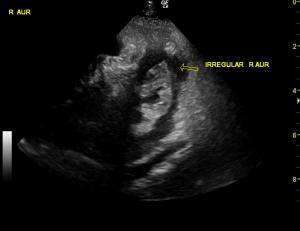– 9 year old soft-coated retriever presented for ADR; tachycardia
– x-rays taken at emerg with only concern for possible mass effect in cranial abdomen. Heart and lungs wnl.
– double cavity ultrasound revealed two small caviatated masses in the spleen – no effusion; no other abnornalities
– moderate pericaridal effusion
– I scanned this dog’s right auricualr appendage in right and left lateral recumbancy as well as in standing position looking for a mass
– 9 year old soft-coated retriever presented for ADR; tachycardia
– x-rays taken at emerg with only concern for possible mass effect in cranial abdomen. Heart and lungs wnl.
– double cavity ultrasound revealed two small caviatated masses in the spleen – no effusion; no other abnornalities
– moderate pericaridal effusion
– I scanned this dog’s right auricualr appendage in right and left lateral recumbancy as well as in standing position looking for a mass
– what I found was a thickened irregular right auricular appendage and what looks like a hyperechoic irregular mass in the right atrium and invading the right ventricle at the level of the tricuspid valve in the left parasternal short-axis veiw of the heart base but I also know how easy it is to create artificats with positioning.
Does this look mass-like or suspicious? With splenic lesions I suspect it is possible.


Comments
Looks like a mass to me in a
Looks like a mass to me in a still but I never call anything on a still image … can you upload a video?
With the breed, age, and
With the breed, age, and splenic nodules metastatic hemangiomia is most likley.
Yes, neoplasia is likely but
Yes, neoplasia is likely but I cannot diagnose it on a still image.
You could as well measure cTnI (>0,25 ng/ml – HAS is likely)
Peter
Thanks guys
I hear ya with
Thanks guys
I hear ya with the clips! These were taken from the clips – had to slow down to even appreciate due to tachyardia.
Peter, what is cTnl? Just a regular cardiac tronponin test that you would use for other cardiac disease like myocarditis?
Jacquie
Abstract:
Chun R, Kellihan
Abstract:
Chun R, Kellihan HB, Henik RA, Stepien RL. Comparison of plasma cardiac troponin I concentrations among dogs with cardiac hemangiosarcoma, noncardiac hemangiosarcoma, other neoplasms, and pericardial effusion of nonhemangiosarcoma origin J Am Vet Med Assoc. 2010, 237:806-811.
OBJECTIVE:
To determine whether plasma cardiac troponin I (cTnl) concentrations can be used to identify cardiac involvement in dogs with hemangiosarcoma, exclude cardiac hemangiosarcoma in dogs with noncardiac hemangiosarcoma, and identify cardiac hemangiosarcoma in dogs with pericardial effusion.
DESIGN:
Cohort study.
ANIMALS:
57 dogs (18 with confirmed [5 dogs] or suspected [13] cardiac hemangiosarcoma, 14 with confirmed hemangiosarcoma involving sites other than the heart [noncardiac hemangiosarcoma], 10 with pericardial effusion not caused by hemangiosarcoma, and 15 with noncardiac nonhemangiosarcoma neoplasms).
PROCEDURES:
Plasma cTnl concentration was measured, and thoracic radiography, abdominal ultrasonography, and echocardiography were performed in each dog. The cTnl concentration was compared among groups.
RESULTS:
Median plasma cTnl concentration in dogs with cardiac hemangiosarcoma was significantly higher than the concentration in each of the other groups. A plasma cTnl concentration > 0.25 ng/mL could be used to identify cardiac involvement in dogs with hemangiosarcoma at any site (sensitivity, 78%; specificity, 71 %). A plasma cTnl concentration > 0.25 ng/mL could be used to identify cardiac hemangiosarcoma in dogs with pericardia effusion (sensitivity, 81%; specificity, 100%).
CONCLUSIONS AND CLINICAL RELEVANCE:
The median plasma cTnl concentration was higher in dogs with cardiac hemangiosarcoma, compared with the median concentration in dogs with hemangiosarcoma at other sites, dogs with other neoplasms, and dogs with pericardial effusion not caused by hemangiosarcoma. The plasma cTnl concentration may be used to identify cardiac involvement in dogs with hemangiosarcoma and to identify cardiac hemangiosarcoma in dogs with pericardial effusion.
That ‘s great thanks Remo!
That ‘s great thanks Remo!
Thanks, Remo!
This is exactly
Thanks, Remo!
This is exactly what I was referring to…
Peter